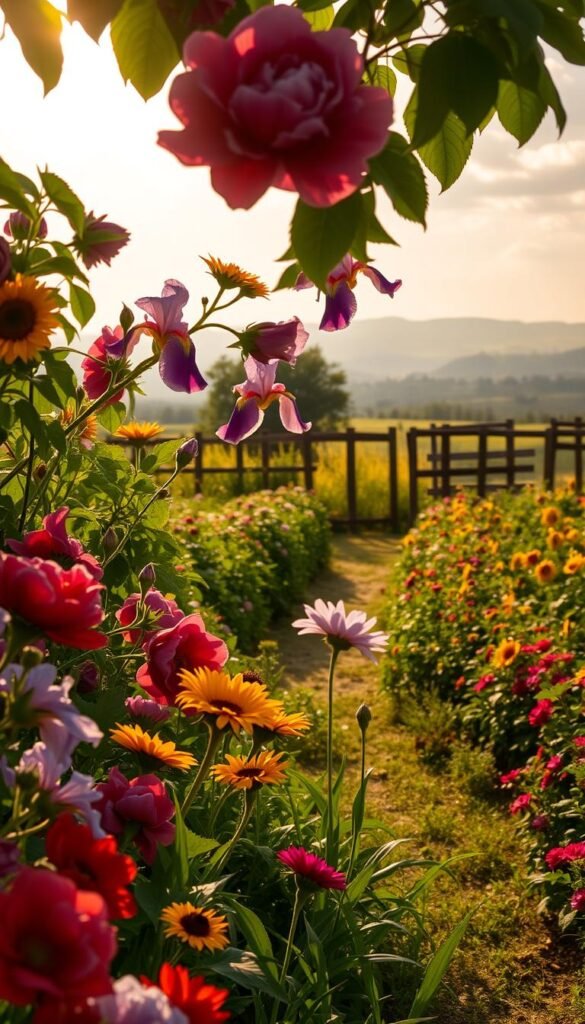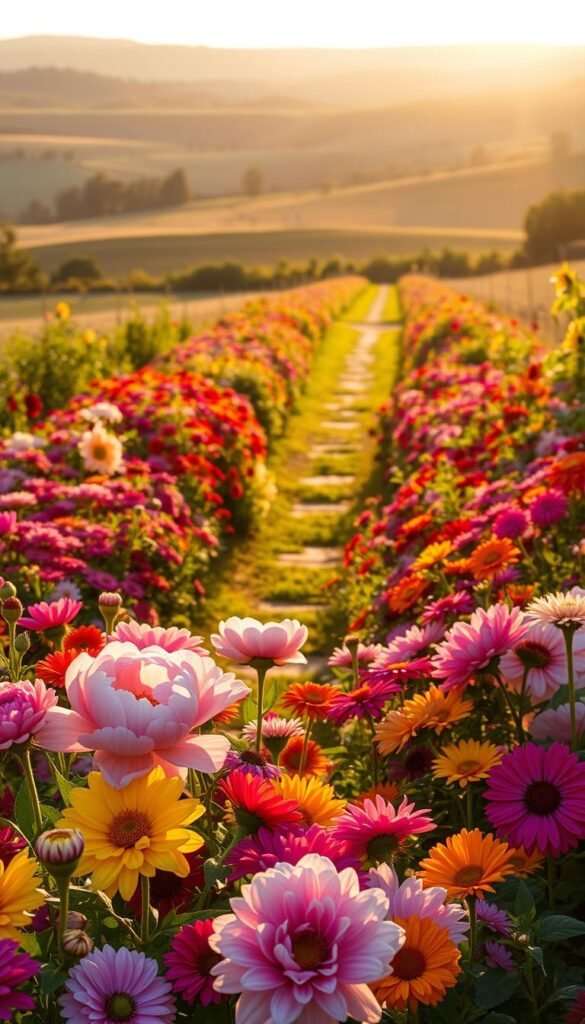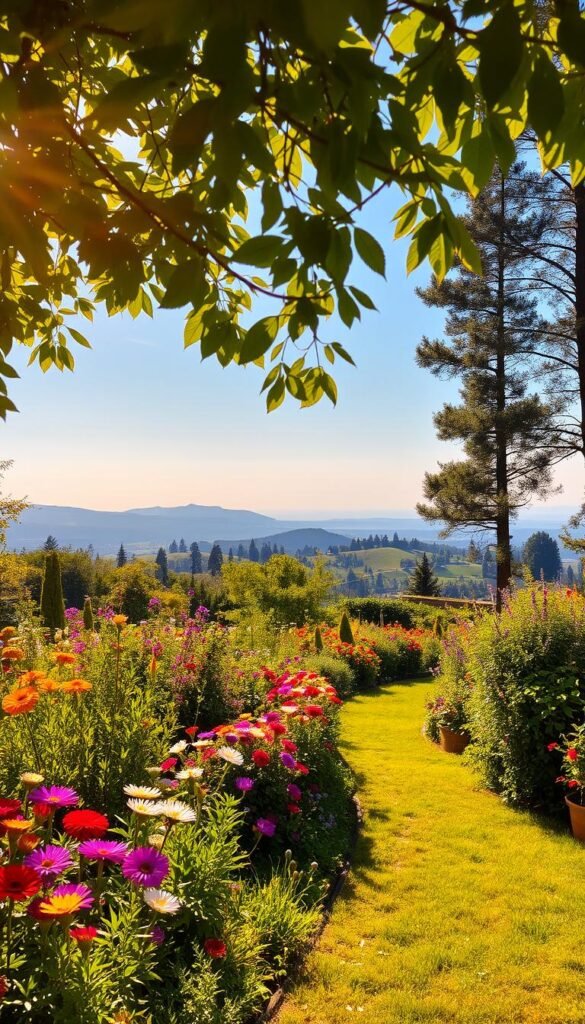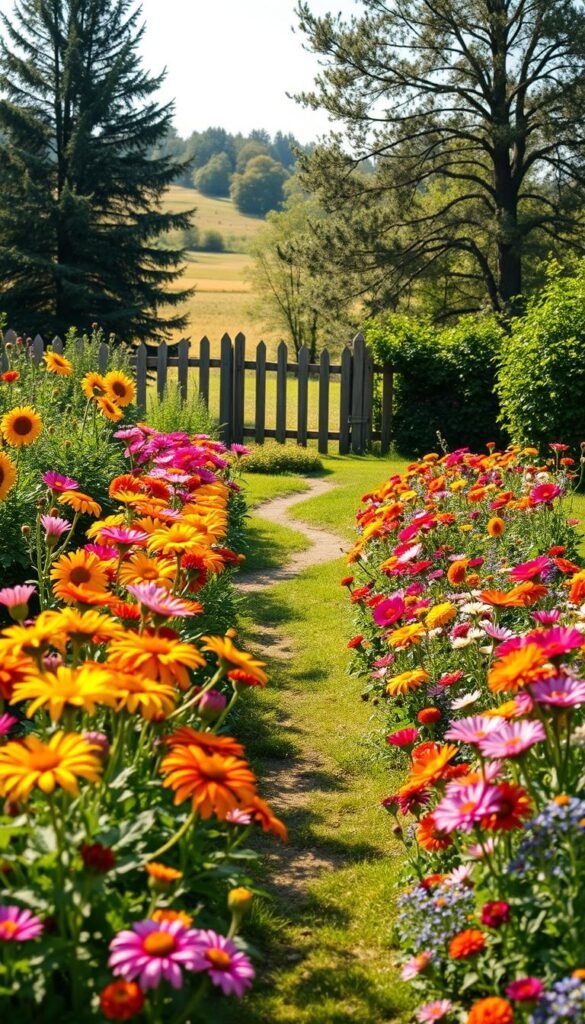Imagine stepping outside to gather fresh, colorful stems whenever you want to brighten your home. A dedicated space for growing blooms lets you create stunning arrangements while connecting with nature. With thoughtful preparation, even first-time growers can enjoy success and avoid overwhelm.
Smart planning transforms your outdoor area into a productive haven. Choosing sun-loving plants suited to your climate ensures steady growth, while strategic spacing simplifies care. Many easy-to-grow blooms like zinnias and sunflowers thrive with minimal fuss, offering weeks of vibrant color.
This guide focuses on practical steps to maximize your harvest. You’ll learn how to position plants for easy access and balance beauty with functionality. Unlike decorative beds, these spaces prioritize long-lasting stems that flourish through multiple seasons.
Discover how simple layouts reduce maintenance while boosting yields. From soil preparation to watering routines, every detail matters. With the right approach, you’ll enjoy armfuls of cheerful blossoms from spring’s first buds to autumn’s final flourish.
Understanding Your Cutting Garden Vision

Creating a space that grows beautiful stems starts with knowing what you want to achieve. Think about how you’ll use your harvest – weekly centerpieces for the kitchen table, gifts for neighbors, or perhaps seasonal decorations for holidays. This clarity shapes every decision, from plant selection to bed sizes.
Setting Your Garden Goals
Start by asking practical questions. How much time can you spend watering and weeding? Do you want blooms from spring through fall? Prioritize low-maintenance varieties like zinnias or marigolds if weekends are busy. A small plot with 10-12 plants often yields enough for regular bouquets without feeling like a second job.
| Plant Type | Role in Arrangements | Examples |
|---|---|---|
| Focal Flowers | Centerpiece blooms | Dahlias, Peonies |
| Fillers | Add volume & texture | Baby’s Breath, Feverfew |
| Airy Accents | Create movement | Cosmos, Queen Anne’s Lace |
Imagining Your Flower Arrangements
Picture the vases on your dining table or entryway. Do you prefer bold monochromatic displays or mixed pastels? Grow plants that match your style – sunflowers for rustic charm, roses for elegance. Designing your cutting garden space becomes easier when you know which stems you’ll need most.
Consider seasonal shifts too. Early tulips give way to summer dahlias, followed by autumn chrysanthemums. Planting in succession ensures you always have something ready to snip. With thoughtful planning, your patch becomes a personal flower shop that changes with the months.
Benefits of Starting a Cut Flower Garden

Experience the joy of homegrown beauty every day. Growing your own stems means endless possibilities for brightening rooms or sharing nature’s artwork. Unlike store-bought options, your creations stay vibrant longer – often lasting over a week with proper care.
Enjoying Fresh Bouquets Daily
Say goodbye to wilted supermarket stems. Homegrown blossoms reach your vase within hours of cutting, preserving their peak freshness. You’ll save money while enjoying higher-quality displays that reflect your personal style.
Morning walks with shears become a cherished routine. Snip lavender for your desk or sunflowers for the kitchen counter. These moments double as gentle exercise and creative inspiration.
Best of all, you control what goes into your soil. No hidden chemicals – just pure, fragrant blooms. Neighbors will admire your container-grown beauties as much as your ground plantings.
Enhancing Your Outdoor Space
Your yard transforms into a living canvas. Colorful petals sway beside pathways, while pollinators buzz happily between blossoms. Even small areas burst with life when planned thoughtfully.
Mix tall spikes of snapdragons with mounding marigolds for visual depth. The result? A landscape that works overtime – beautiful to admire and practical for harvesting. Seasonal changes keep the view exciting from spring’s first buds to autumn’s golden finale.
Planning Your Ideal Garden Layout

Transform your outdoor area into a thriving oasis by mapping out its potential. A well-organized design turns chaos into harmony, letting every stem shine while keeping maintenance manageable.
Sketching a Basic Garden Design
Grab graph paper and measure your plot. Mark permanent structures like fences or trees that cast shadows. These elements become natural borders or supports for climbing plants. Use curved lines for beds to create soft visual flow.
Taller blooms like delphiniums belong behind knee-high marigolds. This layered approach ensures sunlight reaches all plants. Leave 18-inch gaps between rows – you’ll appreciate the elbow room during harvests.
| Plant Height | Recommended Placement | Spacing Needs |
|---|---|---|
| Over 3 ft | Back borders | 24-36 inches |
| 1-3 ft | Middle zones | 12-18 inches |
| Under 1 ft | Front edges | 6-12 inches |
Allocating Space for Blooms and Walkways
Paths matter as much as petals. Use gravel or wood chips to define walkways wide enough for kneeling. These access routes prevent soil compaction near roots. Container arrangements along paths add vertical interest without sacrificing ground space.
Incorporate existing shrubs as living trellises for sweet peas. A bench under that maple tree? Perfect spot for arranging bouquets. Balance open areas with dense plantings – your shears will thank you later.
Choosing the Best Location for Your Garden

Your blooms’ performance depends on smart site selection. Observe your yard like a detective – notice where light lingers and how moisture behaves after rain. These factors determine whether your stems thrive or struggle.
Evaluating Sunlight Exposure
Track sun patterns across three key times: morning, noon, and late afternoon. Use sticks or garden markers to note where shadows fall. Most flowering plants demand six daily hours of direct light – anything less reduces bud production.
Watch for sneaky shade sources like sheds or evergreen trees. South-facing spots often work best, but test your space through all seasons. Morning sun dries dew faster, helping prevent mildew on delicate petals.
Assessing Soil Quality and Drainage
Dig a 12-inch hole and fill it with water. If it drains completely within three hours, you’ve got good flow. Clay-heavy soil needs compost to loosen up, while sandy types require organic matter to retain moisture.
Conduct a simple pH test using kits from garden centers. Most flowering plants prefer slightly acidic soil (6.0-6.5). Remove any competing tree roots within 10 feet of your planned beds – they’ll steal nutrients from your blooms.
| Soil Type | Drainage Speed | Ideal Amendments |
|---|---|---|
| Clay | Slow | Compost, Perlite |
| Sandy | Fast | Peat Moss, Manure |
| Loamy | Moderate | Balanced Fertilizer |
Position your plot near water access – dragging hoses gets old fast. Gentle slopes prevent puddling, while windbreaks protect tall stems from snapping. With these factors checked, your plants will reward you with armloads of vibrant stems.
Preparing Your Garden Beds and Soil
Healthy soil forms the foundation of vibrant, long-lasting arrangements. Before sowing your first seed, invest time in understanding your earth’s composition. This upfront effort pays dividends through stronger plants and more abundant blooms.
Performing a Soil Test
Skip the guesswork with a simple diagnostic check. Home test kits reveal pH levels and nutrient gaps in minutes. For detailed insights, mail samples to agricultural extensions. You’ll discover exactly what amendments your bed needs before planting.
Acidic soil? Add lime. Low phosphorus? Bone meal helps. These adjustments create ideal conditions for roots to thrive. Many new growers regret skipping this step – don’t join them!
Adding Organic Matter and Compost
Mix 50% raised bed soil with 40% compost and 10% coconut coir. This blend offers structure, nutrients, and moisture control. Flower-Tone fertilizer boosts phosphorus for prolific flowering without harsh chemicals.
Refresh beds each spring with fish compost. Come fall, spread shredded leaves to nourish microorganisms. This cycle keeps your soil lively year-round. Your plants will reward you with robust growth and dazzling color displays.






